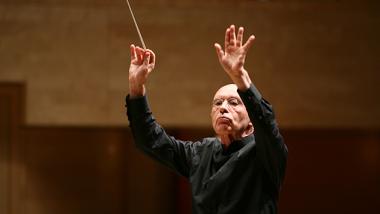
From SFCV Emerging Writers Program
On January 15, the National Symphony Orchestra, conducted by Christoph Eschenbach and featuring piano soloist Tzimon Barto, gave the U.S. premiere of Wolfgang Rihm's Piano Concerto No. 2 at the Kennedy Center in Washington, D.C.
Sandwiched between the garish Dvořák Carnival Overture and dramatic Berlioz Symphonie Fantastique, Rihm’s concerto proved to be a beguilingly introverted contrast. Meandering while bridging unexpected gaps between the endearing and the grave, it perked the ears and put the mind on edge.
Carnival Overture was a well-chosen appetizer. Its brassy forwardness allowed the intimacy of the Rihm to come into focus. Soloist Tzimon Barto began the piece with an insouciant, even jazzy air, giving the irregular rhythms and discordant harmonies an inviting lilt. The piano line merged quickly into the misty textures of the orchestra, and a seamless passing of a musical figure from piano to clarinet, and then to harp, was spine-chillingly pretty. Like a Mozart concerto in which the smiling pianist both plays and conducts, the Rihm had Barto leading shifts in mood with his animated body language while still playing from within the fabric of the ensemble.

Clusters and sweet major triads peeked out of the atonal texture like fleeting mirages, scraping and soothing. The harmonic palette was reminiscent of Berg’s uneasily romantic, abstract-expressionistic sound world, the cerebral formalisms of the Second Viennese School reincarnated beautifully in the Rihm. Images of Schoenberg’s moonlit Pierrot Lunaire and the pointillistic colorings of Webern’s Klangfarbenmelodie came to mind.
But this music is not of the ancient 20th Century. The subtle gradations of sound brought to mind oil rainbows, wispy smoke lines, the glittering grit of asphalt. It’s surprising how doux the orchestral textures were, considering the jagged curtness of each melodic line. Like dots of paint, the short chords overlapped and sequenced at such frequency as to weave soft textures: gauzy linen curtains waving in a breeze.
The subtle gradations of sound brought to mind oil rainbows, wispy smoke lines, the glittering grit of asphalt.The second movement shifted to a darker hue that was nevertheless transparent and beautiful: Dissonant chords rang out proudly like severe metal bars. Even the banging death-knell triplets had a timeless, celestial purity to them.
The cadenza began with what seemed like impromptu Chopin and ended with a string of chromatic pearls and Mozartian runs. This is when one is reminded of Rihm’s tip to first-time listeners of the work: “Imagine that Mozart wrote it — or that Rihm did. But best of all, just listen attentively.”
After the delightful ingenuity of the cadenza cracked some grins, the bleak ending came as a surprise. A long, low, gray cloud set in — a chord so stern and soft so as to make one’s heart stop. We all leaned forward in our seats to observe its entrance. The fog parted briefly for the piano’s sad imitation, the same chord but hard and plain, as the instrument could not recreate the subtlety of the strings’timbre. The fog returned, and faded mystically.
For a man with roots in Darmstadt, Germany, who was taught by none other than Karlheinz Stockhausen (a paragon of detached, post-human, intellectual experimentalism), Rihm has a wonderfully time-transcendent originality and kindness. He channels the lyricism and expression of his predecessors: Mozart, Berg, Schoenberg, Webern, and Schumann in his music, but is none of them at all. It’s rare to hear music that doesn’t seem to try — like magic, the concerto needs no extramusical plot. It is the subtle gradations of color and the amorphous shapes they form that capture the listener. Unlike the other works on the program, the Rihm concerto has no setting or story. It lives and breathes in its chamber-musical form.
With that heartening experience embedded in my psyche I let my mind loose to the exploits of Symphonie Fantastique, allowing myself to ride on the dazzling rollercoaster of sights and emotions. Had I not heard the Rihm, I would’ve labeled it as banal kitsch. But I allowed myself to sink in to the Ranz de Vaches of the pastoral Alps and the gleeful cackles of witches, sans pretension. That evening, all the senses consumed the music.

